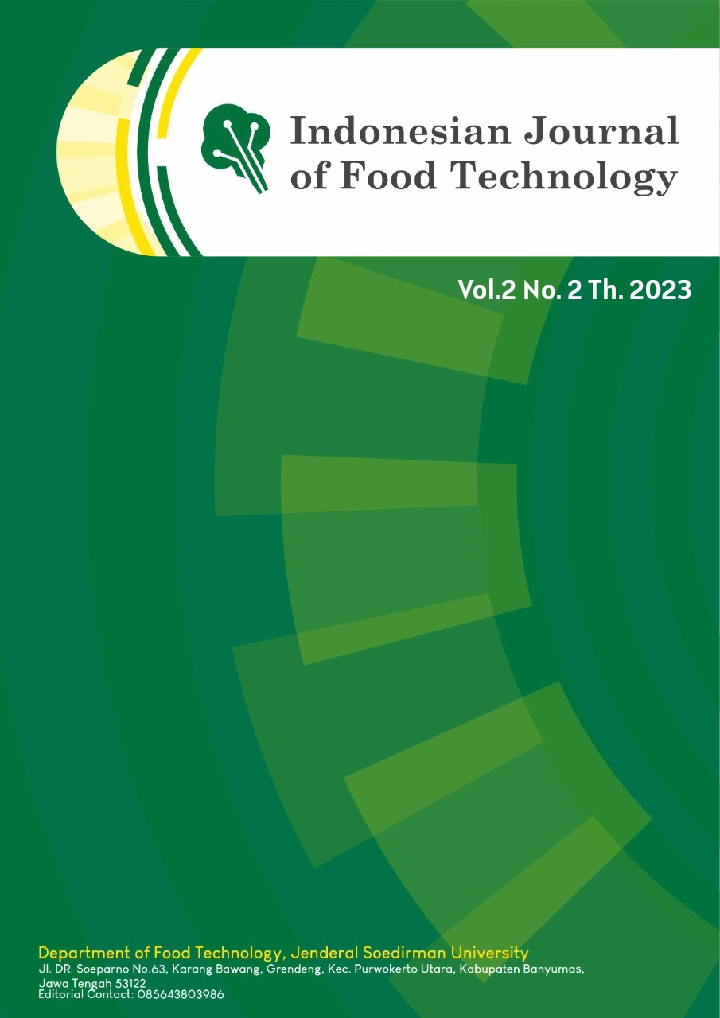Sheeted Catfish Floss Production: Practical Innovation in Fish Floss Processing
Abstract
One of the processed fish that many people like is shredded fish. Choosing shredded fish is an alternative for consumers who don't like to consume meat. Fish also has protein with high nutritional value so it can be used as a source of protein to replace meat. Sheet floss is a processed food product made from catfish floss which is square in shape, brownish in color, hard in texture, and has a rough surface. This research was conducted in November-December 2023 on making shredded catfish sheets. To produce a recipe for shredded catfish sheets requires several production trials. The shredded catfish sheet product produced is in small sheets so it is easy to consume. Making shredded catfish sheets begins with making shredded catfish first. then make shredded sheets by baking. Shredded sheets have a brownish color due to the influence of added sugar, resulting in a Maillard reaction which causes a brownish color. slightly brownish in color. Then, the aroma produced by shredded sheets is not fishy because natural spices are used to eliminate the fishy smell. The taste of the shredded sheets is sweet and savory due to the addition of sugar and the use of spices which add a savory taste. The texture of these shredded sheets is rough, crisp and crunchy because the temperature and time when roasting the shredded shreds is controlled.
References
Chairil Anwar, Irhami, & Kemalawaty, M. (2018). Pengaruh Jenis Ikan dan Metode Pemasakan terhadap Mutu Abon Ikan. Jurnal Teknologi Hasil Perikanan, 7(2), 138-147.
Hasri Amallah. (2019). Proses Pengolahan Dan Mutu Organoleptik Abon Lembaran Dari Ikan Tuna (Thunnus sp.). Politeknik Pertanian Negeri Pangkajene Dan Kepulauan. Pangkep.
Kasmiati, Ekantari, N., Asnani, & Suadi. (2020). Mutu dan Tingkat Kesukaan Konsumen Terhadap Abon Ikan Layang (Decapterus sp.). Jurnal Pengolahan Hasil Perikanan Indonesia, 23(3), 470-478.
Matti, A., Syukroni, I., Fattah, N., & Rusli, A. (2023). Karakteristik Abon Lembaran dari Ikan Bandeng (Chanos chanos) dengan Penambahan Tepung Tapioka. Jurnal FishtecH, 12(1).
Musyaddad, A., & Ramadhani, A. (2019). Produksi Abon Ikan Lele Sebagai Alternatif Usaha untuk Meningkatkan Perekonomian Masyarakat Desa Pelutan. Asian Journal of Innovation and Entrepreneurship, 4(3), 199-206.
Nurilmala, M., & Nurjanah. (2009). Kemunduran Mutu Ikan Lele Dumbo (Clarias gariepinus) pada Penyimpanan Suhu Chilling dengan Perlakuan Cara Mati. Jurnal Pengolahan Hasil Perikanan Indonesia, 12(1).
Sigit, M., Akbar, M., & Fianti, L. (2017). Kualitas Organoleptik Abon Ayam Yang Diberi Perlakuan Substitusi Kacang Tanah (Arachis hypogaea L.). Jurnal Fillia Cendekia, 2(1).
Ubadillah, A., & Hersoelistyorini, W. (2010). Kadar Protein dan Sifat Organoleptik Nugget Rajungan dengan Substitusi Ikan Lele (Clarias gariepinus). Jurnal Pangan dan Gizi, 1(2), 45-54.
Yuswita, E. (2014). Optimasi Proses Termal untuk Membunuh Clostridium botulinum. Jurnal Aplikasi Teknologi Pangan, 3(3).











